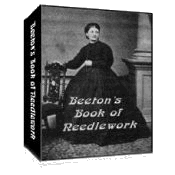Theory and Method of Embroidery

Theory and Method of Embroidery, written by Mrs. L. Barton Wilson, was considered one of the best articles on the subject of embroidery and was published in numerous publications. It is quite lengthy as she does cover all the importance aspects of embroidery.
I have broken down the article is broken down into sections for easy reading or quick perusal. You can read the article in full by following the provided links at the end of the page. This article was considered, in the Victorian era, a MUST read for anyone undertaking embroidery in a serious fashion.
The Theory and Method of Embroidery
Corticelli Home Needlework, 1899
Edited by M. Schlueter
The art of embroidery is worthy of serious consideration and its methods should be studied by those who attempt textile decoration. While admitting that a prescribed method is always secondary to the perfect product, yet one may insist upon a method which experience has proved will accomplish the result in preference to no method and results which are the opposite of success.
The art of embroidery has fallen into a state of dilettanteism for the reason that with the increased popularity of the work a mistaken popular idea has arisen that it is after all a thing to be "picked up" rather than conscientiously studied. No fault of this sort can be found with the old embroideries, because they were executed in convents with the serious purpose of church decoration, or by workers holding commissions of great value from the courts, and therefore received such attention as should be accorded a fine art. Modern embroidery as it is done and taught in the schools on the "other side," together with Japanese and Chinese work, is worthy of the history of the art, and there is no reason why our popular American work should not be as excellent.
The general adaptation of embroidery to household linens is distinctly American, and it is one of those cases in which a thing set apart as it were for a prescribed purpose has been translated, so to speak, into a popular form. This has had two results, one to lower the standard of the work, the other to bring the uplifting influence of such an art into everyday life. The latter result is sufficiently inspiring to appeal to those who attempt the work to make the former impossible by some serious attention to the theory of the work.
The object of the following paper is to fully explain the theory of embroidery and the method for carrying t out. The question of one's authority for laying down a system of rules may naturally arise. A very slight knowledge of the history of embroidery will answer all such questions. Experience has established a science which will convince the inquirer of the dignity of the art. We do not attempt anything new so far as the technique is concerned. We want rather to apply the perfected technique of antique work to our modern ideas and uses of decorated fabrics. The only decoration which is legitimate and, therefore, which is artistic on textile fabrics is embroidery.
When we undertake any other sort the production is not one which has any place in art. Consistency is an element without which no art is possible. Woven threads are the only consistent materials to form a part of woven foundations. The absolute consistency of embroidery as a textile decoration is the secret of its continuous history, and the assurance of its future.

Fig. 3. Stemped Linen Laced into Frame Ready to Work
The fundamental principle of the art lies in the nature of the ground material upon which the work is to be imposed. Fabrics are made under tension and they come out of the loom smooth and equal throughout. It is evident then that if we are to lay a system of stitches over the surface to form another surface as a part of the foundation, we cannot do this successfully unless we have it under tension. Therefore framing embodies the "first principle" and is absolutely essential to all work which has any extension, that is, which is more than mere outline.
The embroiderer must rely in the first place on a stretched surface on which to place her stitches, and not on the possibility of being able to overcome the faults of drawing or looping by a hot iron when the work is finished. Until she is willing to do this she will have results worthy of the name of "fancy work," but not of "art." This brings us to the subject of equipment.
Continue to read article The Theory and Method of Embroidery , Part 1. Equipment.- How to Prepare for Work and the Proper Tools Needed
Return to top of Theory and Method of Embroidery page
The Last and Best Book of Art Needlework
Over 100 pages of authentic Victorian instructions and patterns from 1895!
FREE
Beeton's Book Of Needlework

433 pages!
Sign up for VEAC! Everything you wanted to know about Victorian embroidery, needlework, crafts and more!
Priscilla Bead Work Book
Make Beautiful Victorian Beaded Purses, Jewelry & Accessories - Starting
TODAY!



